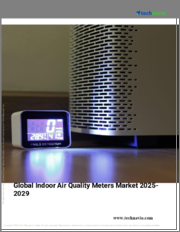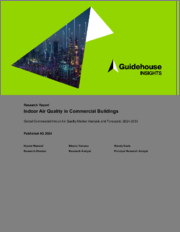
|
시장보고서
상품코드
1576738
세계의 프레시 에어 시스템 시장 : 제품 유형, 구성요소, 기술, 용도, 최종 사용자별 예측(2025-2030년)Fresh Air System Market by Product Type (Single Room Systems, Whole House Systems), Component (Dampers, Fans, Filters), Technology, Application, End User - Global Forecast 2025-2030 |
||||||
프레시 에어 시스템 시장의 2023년 시장 규모는 52억 4,000만 달러로 평가되었습니다. 2024년에는 56억 1,000만 달러에 달할 것으로 예상되며, CAGR 7.35%로 성장하여 2030년에는 86억 2,000만 달러에 달할 것으로 예측됩니다.
프레시 에어 시스템 시장은 HVAC 산업의 광범위한 범위를 포괄하며, 실내 공기질과 거주자의 편안함을 향상시키기 위해 밀폐된 공간에 신선한 공기를 통합하는 솔루션에 초점을 맞추었습니다. 프레시 에어 시스템의 필요성은 실내 오염이 건강에 미치는 악영향에 대한 인식이 높아지고 엄격한 건축 규제가 강화되면서 더욱 강조되고 있습니다. 이 시스템은 최적의 공기 순환을 유지하고 오염 물질의 축적을 방지하는 것이 중요한 주거, 상업 및 산업 분야에 적용되고 있습니다. 최종 용도의 범위에는 에너지 효율과 지속 가능한 운영을 우선시하는 스마트 빌딩 기술 및 HVAC 프레임워크에의 통합이 포함됩니다. 시장 성장의 원동력은 스마트하고 에너지 효율적인 HVAC 시스템에 대한 수요 증가, 도시화 및 인프라 현대화입니다. 실시간 공기질 모니터링을 위한 IoT 지원 시스템, 예지보전을 위한 AI 통합과 같은 기술 발전은 잠재적인 기회로 작용할 수 있습니다. 적응형 공기 여과 기술이나 재생 가능 에너지로 구동되는 시스템에 대한 연구와 혁신에 집중함으로써 이러한 기회를 포착할 수 있습니다. 그러나 높은 초기 설치 비용, 유지보수의 복잡성, 신흥국 시장에서의 소비자 인식 부족 등이 시장 침투에 걸림돌이 될 수 있습니다. 또한, 전 세계 다양한 기후와 건축 양식에 따른 표준화 문제도 있습니다. 이러한 문제를 극복하기 위해 기업들은 인식 개선 캠페인에 투자하여 인지도를 높이고, 신축 건물에 이러한 시스템을 원활하게 통합할 수 있도록 건설사와의 제휴를 모색해야 합니다. 또한, 현지 기후에 맞는 비용 효율적인 솔루션의 연구개발에 투자하는 것도 큰 경쟁 우위를 가져올 수 있습니다. 급속한 기술 변화와 소비자 선호도의 변화로 인해 끊임없이 변화하는 역동적인 특성을 지닌 프레시 에어 시스템 시장은 사업 전략의 민첩성과 지속적인 혁신이 성장과 시장 관련성을 유지하는 데 있어 중요하다는 것을 분명히 보여줍니다.
| 주요 시장 통계 | |
|---|---|
| 기준연도(2023년) | 52억 4,000만 달러 |
| 예측 연도(2024년) | 56억 1,000만 달러 |
| 예측 연도(2030년) | 86억 2,000만 달러 |
| CAGR(%) | 7.35% |
시장 역학: 빠르게 진화하는 프레시 에어 시스템 시장의 주요 시장 인사이트 공개
프레시 에어 시스템 시장은 수요 및 공급의 역동적인 상호작용에 의해 변화하고 있습니다. 이러한 시장 역학의 변화를 이해함으로써 기업은 정보에 입각한 투자 결정을 내리고, 전략적인 의사결정을 정교화하며, 새로운 비즈니스 기회를 포착할 수 있습니다. 이러한 트렌드를 종합적으로 파악함으로써 기업은 정치적, 지리적, 기술적, 사회적, 경제적 영역 전반에 걸친 다양한 리스크를 줄일 수 있으며, 소비자 행동과 그것이 제조 비용 및 구매 동향에 미치는 영향을 보다 명확하게 이해할 수 있습니다.
- 시장 성장 촉진요인
- 실내 공기의 질과 그것이 건강과 행복에 미치는 영향에 대한 인식 증가
- 공기 정화 및 환기 시스템의 기술 발전이 시장 성장을 주도합니다.
- 실내 공기질에 대한 정부 규제 및 기준 증가
- 주거 및 상업 부문에서 에너지 효율적이고 친환경적인 환기 솔루션에 대한 수요가 증가하고 있습니다.
- 시장 성장 억제요인
- 프레시 에어 시스템 사용 부족으로 이어지는 소비자의 인식과 이해 부족
- 시장 기회
- 실내 공기질에 대한 인식이 높아지면서 소비자들 사이에서 고급 공기청정 시스템 시장을 주도하고 있습니다.
- 더 나은 실내 환경을 위해 프레시 에어 시스템을 통합한 스마트홈 기술이 급증하고 있습니다.
- 환자의 안전을 위해 고성능 공기 여과 시스템을 필요로 하는 의료 시설의 확대
- 시장 과제
- 표준화 부족으로 인한 프레시 에어 시스템 개발의 장애요인
Portre's Five Forces: 프레시 에어 시스템 시장 탐색을 위한 전략 도구
Portre's Five Forces 프레임워크는 프레시 에어 시스템 시장 경쟁 구도를 이해하는 데 중요한 도구입니다. Portre's Five Forces 프레임워크는 기업의 경쟁력을 평가하고 전략적 기회를 모색할 수 있는 명확한 방법을 제공합니다. 이 프레임워크는 기업이 시장 내 세력도를 평가하고 신규 사업의 수익성을 판단하는 데 도움이 됩니다. 이러한 통찰력을 통해 기업은 강점을 활용하고, 약점을 해결하고, 잠재적인 도전을 피하고, 보다 강력한 시장 포지셔닝을 확보할 수 있습니다.
PESTLE 분석 : 프레시 에어 시스템 시장에서의 외부 영향 파악
외부 거시 환경 요인은 프레시 에어 시스템 시장의 성과 역학을 형성하는 데 매우 중요한 역할을 합니다. 정치적, 경제적, 사회적, 기술적, 법적, 환경적 요인에 대한 분석은 이러한 영향을 탐색하는 데 필요한 정보를 제공하며, PESTLE 요인을 조사함으로써 기업은 잠재적 위험과 기회를 더 잘 이해할 수 있습니다. 이러한 분석을 통해 기업은 규제, 소비자 선호도, 경제 동향의 변화를 예측하고 선제적이고 능동적인 의사결정을 내릴 준비를 할 수 있습니다.
시장 점유율 분석 프레시 에어 시스템 시장에서경쟁 구도 파악
프레시 에어 시스템 시장의 상세한 시장 점유율 분석을 통해 벤더의 성과를 종합적으로 평가할 수 있습니다. 기업은 수익, 고객 기반, 성장률과 같은 주요 지표를 비교하여 경쟁적 위치를 파악할 수 있습니다. 이 분석은 시장의 집중화, 단편화, 통합의 추세를 파악할 수 있으며, 공급업체는 치열한 경쟁 속에서 자신의 입지를 강화할 수 있는 전략적 의사결정을 내리는 데 필요한 통찰력을 얻을 수 있습니다.
FPNV 포지셔닝 매트릭스 프레쉬 에어 시스템 시장에서의 벤더 성과 평가
FPNV 포지셔닝 매트릭스는 프레시 에어 시스템 시장에서 벤더를 평가하는 중요한 도구입니다. 이 매트릭스를 통해 비즈니스 조직은 벤더의 비즈니스 전략과 제품 만족도를 기반으로 평가하여 목표에 부합하는 정보에 입각한 의사결정을 내릴 수 있으며, 4개의 사분면으로 벤더를 명확하고 정확하게 세분화하여 전략 목표에 가장 적합한 파트너와 솔루션을 식별할 수 있습니다. 전략 목표에 가장 적합한 파트너와 솔루션을 식별할 수 있습니다.
프레시 에어 시스템 시장에서 성공하기 위한 전략 분석 및 권장 사항
프레시 에어 시스템 시장 전략 분석은 세계 시장에서 입지를 강화하고자 하는 기업에게 필수적입니다. 주요 자원, 역량 및 성과 지표를 검토함으로써 기업은 성장 기회를 식별하고 개선할 수 있습니다. 이러한 접근 방식을 통해 경쟁 환경의 도전을 극복하고 새로운 비즈니스 기회를 활용하여 장기적인 성공을 거둘 수 있도록 준비할 수 있습니다.
이 보고서는 주요 관심 분야를 포괄하는 시장에 대한 종합적인 분석을 제공합니다.
1. 시장 침투도 : 현재 시장 환경의 상세한 검토, 주요 기업의 광범위한 데이터, 시장 도달 범위 및 전반적인 영향력 평가.
2. 시장 개척도: 신흥 시장에서의 성장 기회를 파악하고, 기존 분야의 확장 가능성을 평가하며, 미래 성장을 위한 전략적 로드맵을 제공합니다.
3. 시장 다각화 : 최근 제품 출시, 미개척 지역, 업계의 주요 발전, 시장을 형성하는 전략적 투자를 분석합니다.
4. 경쟁 평가 및 정보 : 경쟁 구도를 철저히 분석하여 시장 점유율, 사업 전략, 제품 포트폴리오, 인증, 규제 당국의 승인, 특허 동향, 주요 기업의 기술 발전 등을 검토합니다.
5. 제품 개발 및 혁신 : 미래 시장 성장을 가속할 것으로 예상되는 첨단 기술, 연구 개발 활동 및 제품 혁신을 강조합니다.
이해관계자들이 충분한 정보를 바탕으로 의사결정을 내릴 수 있도록 다음과 같은 중요한 질문에 대한 답변도 제공합니다.
1. 현재 시장 규모와 향후 성장 전망은?
2. 최고의 투자 기회를 제공하는 제품, 부문, 지역은?
3. 시장을 형성하는 주요 기술 동향과 규제의 영향은?
4. 주요 벤더의 시장 점유율과 경쟁 포지션은?
5.벤더 시장 진입 및 철수 전략의 원동력이 되는 수익원과 전략적 기회는 무엇인가?
목차
제1장 서문
제2장 조사 방법
제3장 주요 요약
제4장 시장 개요
제5장 시장 인사이트
- 시장 역학
- 성장 촉진요인
- 성장 억제요인
- 기회
- 과제
- 시장 세분화 분석
- Porter의 Five Forces 분석
- PESTEL 분석
- 정치적
- 경제
- 사교
- 기술적
- 법률상
- 환경
제6장 프레시 에어 시스템 시장 : 제품 유형별
- Single Room Systems
- Whole House Systems
제7장 프레시 에어 시스템 시장 : 컴포넌트별
- 댐퍼
- 자동 댐퍼
- 수동 댐퍼
- 팬
- 축류 팬
- 원심 팬
- 필터
- HEPA 필터
- 프라이머리 필터
- 2차 필터
- 환기 시스템
- 기계 환기 시스템
- 자연 환기 시스템
제8장 프레시 에어 시스템 시장 : 기술별
- 스마트 환기 시스템
- 기존 환기 시스템
제9장 프레시 에어 시스템 시장 : 용도별
- 상업
- 산업
- 주택
제10장 프레시 에어 시스템 시장 : 최종사용자별
- 빌더
- 주택 소유자
- 부동산 관리 회사
제11장 아메리카의 프레시 에어 시스템 시장
- 아르헨티나
- 브라질
- 캐나다
- 멕시코
- 미국
제12장 아시아태평양의 프레시 에어 시스템 시장
- 호주
- 중국
- 인도
- 인도네시아
- 일본
- 말레이시아
- 필리핀
- 싱가포르
- 한국
- 대만
- 태국
- 베트남
제13장 유럽, 중동 및 아프리카의 프레시 에어 시스템 시장
- 덴마크
- 이집트
- 핀란드
- 프랑스
- 독일
- 이스라엘
- 이탈리아
- 네덜란드
- 나이지리아
- 노르웨이
- 폴란드
- 카타르
- 러시아
- 사우디아라비아
- 남아프리카공화국
- 스페인
- 스웨덴
- 스위스
- 터키
- 아랍에미리트(UAE)
- 영국
제14장 경쟁 구도
- 시장 점유율 분석, 2023년
- FPNV 포지셔닝 매트릭스, 2023년
- 경쟁 시나리오 분석
- 전략 분석과 제안
기업 리스트
- 1. Bosch Thermotechnology
- 2. Carrier Global Corporation
- 3. Daikin Industries, Ltd.
- 4. Emerson Electric Co.
- 5. Fujitsu General Limited
- 6. Hitachi Ltd.
- 7. Honeywell International Inc.
- 8. Ingersoll Rand Inc.
- 9. Johnson Controls International plc
- 10. Lennox International Inc.
- 11. LG Electronics Inc.
- 12. Mitsubishi Electric Corporation
- 13. Nortek Global HVAC
- 14. Panasonic Corporation
- 15. Samsung Electronics Co., Ltd.
- 16. Schneider Electric SE
- 17. Siemens AG
- 18. Toshiba Carrier Corporation
- 19. Trane Technologies plc
- 20. United Technologies Corporation
The Fresh Air System Market was valued at USD 5.24 billion in 2023, expected to reach USD 5.61 billion in 2024, and is projected to grow at a CAGR of 7.35%, to USD 8.62 billion by 2030.
The fresh air system market encompasses a broad scope within the HVAC industry, focusing on solutions that integrate fresh air into enclosed spaces to enhance indoor air quality and occupant well-being. The necessity for fresh air systems is underscored by growing awareness of indoor pollution's adverse health impacts and stringent building regulations. These systems find applications in residential, commercial, and industrial sectors, where they are critical for maintaining optimal air circulation and preventing pollutant buildup. End-use scopes include integration in smart building technologies and HVAC frameworks that prioritize energy efficiency and sustainable operation. Market growth is driven by escalating demand for smart and energy-efficient HVAC systems, increasing urbanization, and modernization of infrastructure. Technological advancements, such as IoT-enabled systems for real-time air quality monitoring, and the inclusion of AI for predictive maintenance, serve as potential opportunities. These can be seized by focusing research and innovation on adaptive air filtration technologies and renewable energy-powered systems. However, challenges include high initial installation costs, maintenance complexities, and a lack of consumer awareness in developing regions, which can hinder market penetration. There is also the issue of standardization across varied climates and architectural styles worldwide. To navigate these challenges, companies should invest in education campaigns to raise awareness and explore partnerships with construction firms for seamless integration of these systems into new builds. Investment in R&D for cost-effective solutions tailored to local climates could offer significant competitive advantages. The fresh air system market is characterized by a dynamic nature, punctuated by rapid technological shifts and evolving consumer preferences, underlining the importance of agility in business strategy and continuous innovation to sustain growth and market relevance.
| KEY MARKET STATISTICS | |
|---|---|
| Base Year [2023] | USD 5.24 billion |
| Estimated Year [2024] | USD 5.61 billion |
| Forecast Year [2030] | USD 8.62 billion |
| CAGR (%) | 7.35% |
Market Dynamics: Unveiling Key Market Insights in the Rapidly Evolving Fresh Air System Market
The Fresh Air System Market is undergoing transformative changes driven by a dynamic interplay of supply and demand factors. Understanding these evolving market dynamics prepares business organizations to make informed investment decisions, refine strategic decisions, and seize new opportunities. By gaining a comprehensive view of these trends, business organizations can mitigate various risks across political, geographic, technical, social, and economic domains while also gaining a clearer understanding of consumer behavior and its impact on manufacturing costs and purchasing trends.
- Market Drivers
- Rising awareness about indoor air quality and its impact on health and well-being
- Technological advancements in air purification and ventilation systems driving market growth
- Increasing government regulations and standards for indoor air quality
- Growing demand for energy-efficient and eco-friendly air ventilation solutions in residential and commercial sectors
- Market Restraints
- Limited awareness and understanding among consumers leading to underutilization of fresh air systems
- Market Opportunities
- Growing awareness about indoor air quality driving the market for advanced fresh air systems among consumers
- The surge in smart home technologies integrating fresh air systems for better indoor environments
- Expansion of healthcare facilities requiring high-performance air filtration systems for patient safety
- Market Challenges
- Lack of standardization creating barriers for development of fresh air system
Porter's Five Forces: A Strategic Tool for Navigating the Fresh Air System Market
Porter's five forces framework is a critical tool for understanding the competitive landscape of the Fresh Air System Market. It offers business organizations with a clear methodology for evaluating their competitive positioning and exploring strategic opportunities. This framework helps businesses assess the power dynamics within the market and determine the profitability of new ventures. With these insights, business organizations can leverage their strengths, address weaknesses, and avoid potential challenges, ensuring a more resilient market positioning.
PESTLE Analysis: Navigating External Influences in the Fresh Air System Market
External macro-environmental factors play a pivotal role in shaping the performance dynamics of the Fresh Air System Market. Political, Economic, Social, Technological, Legal, and Environmental factors analysis provides the necessary information to navigate these influences. By examining PESTLE factors, businesses can better understand potential risks and opportunities. This analysis enables business organizations to anticipate changes in regulations, consumer preferences, and economic trends, ensuring they are prepared to make proactive, forward-thinking decisions.
Market Share Analysis: Understanding the Competitive Landscape in the Fresh Air System Market
A detailed market share analysis in the Fresh Air System Market provides a comprehensive assessment of vendors' performance. Companies can identify their competitive positioning by comparing key metrics, including revenue, customer base, and growth rates. This analysis highlights market concentration, fragmentation, and trends in consolidation, offering vendors the insights required to make strategic decisions that enhance their position in an increasingly competitive landscape.
FPNV Positioning Matrix: Evaluating Vendors' Performance in the Fresh Air System Market
The Forefront, Pathfinder, Niche, Vital (FPNV) Positioning Matrix is a critical tool for evaluating vendors within the Fresh Air System Market. This matrix enables business organizations to make well-informed decisions that align with their goals by assessing vendors based on their business strategy and product satisfaction. The four quadrants provide a clear and precise segmentation of vendors, helping users identify the right partners and solutions that best fit their strategic objectives.
Strategy Analysis & Recommendation: Charting a Path to Success in the Fresh Air System Market
A strategic analysis of the Fresh Air System Market is essential for businesses looking to strengthen their global market presence. By reviewing key resources, capabilities, and performance indicators, business organizations can identify growth opportunities and work toward improvement. This approach helps businesses navigate challenges in the competitive landscape and ensures they are well-positioned to capitalize on newer opportunities and drive long-term success.
Key Company Profiles
The report delves into recent significant developments in the Fresh Air System Market, highlighting leading vendors and their innovative profiles. These include Bosch Thermotechnology, Carrier Global Corporation, Daikin Industries, Ltd., Emerson Electric Co., Fujitsu General Limited, Hitachi Ltd., Honeywell International Inc., Ingersoll Rand Inc., Johnson Controls International plc, Lennox International Inc., LG Electronics Inc., Mitsubishi Electric Corporation, Nortek Global HVAC, Panasonic Corporation, Samsung Electronics Co., Ltd., Schneider Electric SE, Siemens AG, Toshiba Carrier Corporation, Trane Technologies plc, and United Technologies Corporation.
Market Segmentation & Coverage
This research report categorizes the Fresh Air System Market to forecast the revenues and analyze trends in each of the following sub-markets:
- Based on Product Type, market is studied across Single Room Systems and Whole House Systems.
- Based on Component, market is studied across Dampers, Fans, Filters, and Ventilation Systems. The Dampers is further studied across Automatic Dampers and Manual Dampers. The Fans is further studied across Axial Fans and Centrifugal Fans. The Filters is further studied across HEPA Filters, Primary Filters, and Secondary Filters. The Ventilation Systems is further studied across Mechanical Ventilation Systems and Natural Ventilation Systems.
- Based on Technology, market is studied across Smart Ventilation Systems and Traditional Ventilation Systems.
- Based on Application, market is studied across Commercial, Industrial, and Residential.
- Based on End User, market is studied across Builders, Homeowners, and Property Managers.
- Based on Region, market is studied across Americas, Asia-Pacific, and Europe, Middle East & Africa. The Americas is further studied across Argentina, Brazil, Canada, Mexico, and United States. The United States is further studied across California, Florida, Illinois, New York, Ohio, Pennsylvania, and Texas. The Asia-Pacific is further studied across Australia, China, India, Indonesia, Japan, Malaysia, Philippines, Singapore, South Korea, Taiwan, Thailand, and Vietnam. The Europe, Middle East & Africa is further studied across Denmark, Egypt, Finland, France, Germany, Israel, Italy, Netherlands, Nigeria, Norway, Poland, Qatar, Russia, Saudi Arabia, South Africa, Spain, Sweden, Switzerland, Turkey, United Arab Emirates, and United Kingdom.
The report offers a comprehensive analysis of the market, covering key focus areas:
1. Market Penetration: A detailed review of the current market environment, including extensive data from top industry players, evaluating their market reach and overall influence.
2. Market Development: Identifies growth opportunities in emerging markets and assesses expansion potential in established sectors, providing a strategic roadmap for future growth.
3. Market Diversification: Analyzes recent product launches, untapped geographic regions, major industry advancements, and strategic investments reshaping the market.
4. Competitive Assessment & Intelligence: Provides a thorough analysis of the competitive landscape, examining market share, business strategies, product portfolios, certifications, regulatory approvals, patent trends, and technological advancements of key players.
5. Product Development & Innovation: Highlights cutting-edge technologies, R&D activities, and product innovations expected to drive future market growth.
The report also answers critical questions to aid stakeholders in making informed decisions:
1. What is the current market size, and what is the forecasted growth?
2. Which products, segments, and regions offer the best investment opportunities?
3. What are the key technology trends and regulatory influences shaping the market?
4. How do leading vendors rank in terms of market share and competitive positioning?
5. What revenue sources and strategic opportunities drive vendors' market entry or exit strategies?
Table of Contents
1. Preface
- 1.1. Objectives of the Study
- 1.2. Market Segmentation & Coverage
- 1.3. Years Considered for the Study
- 1.4. Currency & Pricing
- 1.5. Language
- 1.6. Stakeholders
2. Research Methodology
- 2.1. Define: Research Objective
- 2.2. Determine: Research Design
- 2.3. Prepare: Research Instrument
- 2.4. Collect: Data Source
- 2.5. Analyze: Data Interpretation
- 2.6. Formulate: Data Verification
- 2.7. Publish: Research Report
- 2.8. Repeat: Report Update
3. Executive Summary
4. Market Overview
5. Market Insights
- 5.1. Market Dynamics
- 5.1.1. Drivers
- 5.1.1.1. Rising awareness about indoor air quality and its impact on health and well-being
- 5.1.1.2. Technological advancements in air purification and ventilation systems driving market growth
- 5.1.1.3. Increasing government regulations and standards for indoor air quality
- 5.1.1.4. Growing demand for energy-efficient and eco-friendly air ventilation solutions in residential and commercial sectors
- 5.1.2. Restraints
- 5.1.2.1. Limited awareness and understanding among consumers leading to underutilization of fresh air systems
- 5.1.3. Opportunities
- 5.1.3.1. Growing awareness about indoor air quality driving the market for advanced fresh air systems among consumers
- 5.1.3.2. The surge in smart home technologies integrating fresh air systems for better indoor environments
- 5.1.3.3. Expansion of healthcare facilities requiring high-performance air filtration systems for patient safety
- 5.1.4. Challenges
- 5.1.4.1. Lack of standardization creating barriers for development of fresh air system
- 5.1.1. Drivers
- 5.2. Market Segmentation Analysis
- 5.3. Porter's Five Forces Analysis
- 5.3.1. Threat of New Entrants
- 5.3.2. Threat of Substitutes
- 5.3.3. Bargaining Power of Customers
- 5.3.4. Bargaining Power of Suppliers
- 5.3.5. Industry Rivalry
- 5.4. PESTLE Analysis
- 5.4.1. Political
- 5.4.2. Economic
- 5.4.3. Social
- 5.4.4. Technological
- 5.4.5. Legal
- 5.4.6. Environmental
6. Fresh Air System Market, by Product Type
- 6.1. Introduction
- 6.2. Single Room Systems
- 6.3. Whole House Systems
7. Fresh Air System Market, by Component
- 7.1. Introduction
- 7.2. Dampers
- 7.2.1. Automatic Dampers
- 7.2.2. Manual Dampers
- 7.3. Fans
- 7.3.1. Axial Fans
- 7.3.2. Centrifugal Fans
- 7.4. Filters
- 7.4.1. HEPA Filters
- 7.4.2. Primary Filters
- 7.4.3. Secondary Filters
- 7.5. Ventilation Systems
- 7.5.1. Mechanical Ventilation Systems
- 7.5.2. Natural Ventilation Systems
8. Fresh Air System Market, by Technology
- 8.1. Introduction
- 8.2. Smart Ventilation Systems
- 8.3. Traditional Ventilation Systems
9. Fresh Air System Market, by Application
- 9.1. Introduction
- 9.2. Commercial
- 9.3. Industrial
- 9.4. Residential
10. Fresh Air System Market, by End User
- 10.1. Introduction
- 10.2. Builders
- 10.3. Homeowners
- 10.4. Property Managers
11. Americas Fresh Air System Market
- 11.1. Introduction
- 11.2. Argentina
- 11.3. Brazil
- 11.4. Canada
- 11.5. Mexico
- 11.6. United States
12. Asia-Pacific Fresh Air System Market
- 12.1. Introduction
- 12.2. Australia
- 12.3. China
- 12.4. India
- 12.5. Indonesia
- 12.6. Japan
- 12.7. Malaysia
- 12.8. Philippines
- 12.9. Singapore
- 12.10. South Korea
- 12.11. Taiwan
- 12.12. Thailand
- 12.13. Vietnam
13. Europe, Middle East & Africa Fresh Air System Market
- 13.1. Introduction
- 13.2. Denmark
- 13.3. Egypt
- 13.4. Finland
- 13.5. France
- 13.6. Germany
- 13.7. Israel
- 13.8. Italy
- 13.9. Netherlands
- 13.10. Nigeria
- 13.11. Norway
- 13.12. Poland
- 13.13. Qatar
- 13.14. Russia
- 13.15. Saudi Arabia
- 13.16. South Africa
- 13.17. Spain
- 13.18. Sweden
- 13.19. Switzerland
- 13.20. Turkey
- 13.21. United Arab Emirates
- 13.22. United Kingdom
14. Competitive Landscape
- 14.1. Market Share Analysis, 2023
- 14.2. FPNV Positioning Matrix, 2023
- 14.3. Competitive Scenario Analysis
- 14.4. Strategy Analysis & Recommendation
Companies Mentioned
- 1. Bosch Thermotechnology
- 2. Carrier Global Corporation
- 3. Daikin Industries, Ltd.
- 4. Emerson Electric Co.
- 5. Fujitsu General Limited
- 6. Hitachi Ltd.
- 7. Honeywell International Inc.
- 8. Ingersoll Rand Inc.
- 9. Johnson Controls International plc
- 10. Lennox International Inc.
- 11. LG Electronics Inc.
- 12. Mitsubishi Electric Corporation
- 13. Nortek Global HVAC
- 14. Panasonic Corporation
- 15. Samsung Electronics Co., Ltd.
- 16. Schneider Electric SE
- 17. Siemens AG
- 18. Toshiba Carrier Corporation
- 19. Trane Technologies plc
- 20. United Technologies Corporation



















